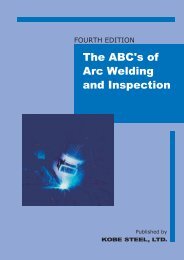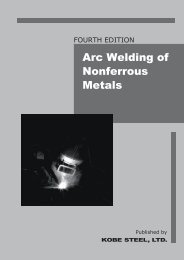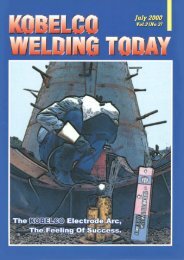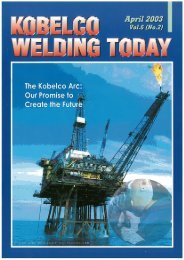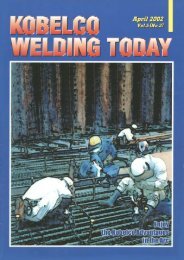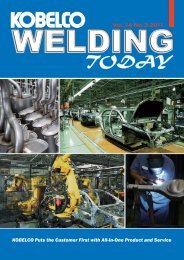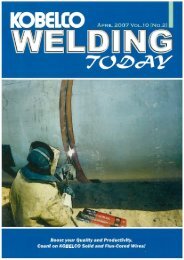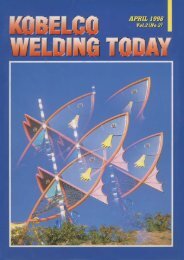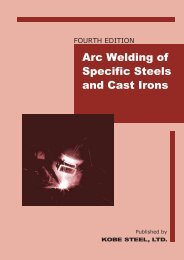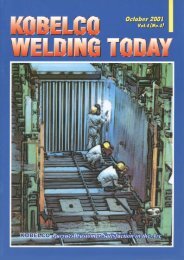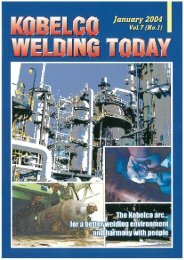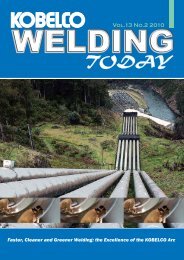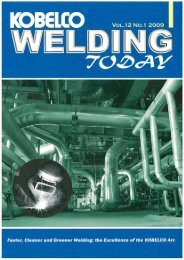Essential Factors in Gas Metal Arc Welding
Essential Factors in Gas Metal Arc Welding
Essential Factors in Gas Metal Arc Welding
You also want an ePaper? Increase the reach of your titles
YUMPU automatically turns print PDFs into web optimized ePapers that Google loves.
FOURTH EDITION<br />
<strong>Essential</strong> <strong>Factors</strong><br />
<strong>in</strong> <strong>Gas</strong> <strong>Metal</strong> <strong>Arc</strong><br />
Weld<strong>in</strong>g<br />
Published by
FOURTH EDITION<br />
<strong>Essential</strong> <strong>Factors</strong><br />
<strong>in</strong> <strong>Gas</strong> <strong>Metal</strong> <strong>Arc</strong><br />
Weld<strong>in</strong>g<br />
Kita-Sh<strong>in</strong>agawa, Sh<strong>in</strong>agawa-Ku, Tokyo, 141-8688 Japan
Published by KOBE STEEL, LTD.<br />
© 2011 by KOBE STEEL, LTD.<br />
5-912, Kita-Sh<strong>in</strong>agawa, Sh<strong>in</strong>agawa-Ku, Tokyo<br />
141-8688 Japan<br />
All rights reserved. No part of this book may be<br />
reproduced, <strong>in</strong> any form or by any means, without<br />
permission <strong>in</strong> writ<strong>in</strong>g from the publisher.<br />
The <strong>Essential</strong> <strong>Factors</strong> <strong>in</strong> <strong>Gas</strong> <strong>Metal</strong> <strong>Arc</strong> Weld<strong>in</strong>g is to<br />
provide <strong>in</strong>formation to assist weld<strong>in</strong>g personnel study<br />
the arc weld<strong>in</strong>g technologies commonly applied <strong>in</strong> gas<br />
metal arc weld<strong>in</strong>g.<br />
Reasonable care is taken <strong>in</strong> the compilation and<br />
publication of this textbook to <strong>in</strong>sure authenticity of<br />
the contents. No representation or warranty is made as<br />
to the accuracy or reliability of this <strong>in</strong>formation.
Introduction<br />
Nowadays, gas metal arc weld<strong>in</strong>g (GMAW) is widely used <strong>in</strong> various constructions such as<br />
steel structures, bridges, autos, motorcycles, construction mach<strong>in</strong>ery, ships, offshore structures,<br />
pressure vessels, and pipel<strong>in</strong>es due to high weld<strong>in</strong>g efficiency. This weld<strong>in</strong>g process, however,<br />
requires specific weld<strong>in</strong>g knowledge and techniques to accomplish sound weldments. The<br />
quality of weldments made by GMAW is markedly affected by the weld<strong>in</strong>g parameters set by a<br />
welder or a weld<strong>in</strong>g operator. In addition, how to handle the weld<strong>in</strong>g equipment is the key to<br />
obta<strong>in</strong> quality welds. The use of a wrong weld<strong>in</strong>g parameter or mishandl<strong>in</strong>g the weld<strong>in</strong>g<br />
equipment will result <strong>in</strong> unacceptable weldments that conta<strong>in</strong> weld<strong>in</strong>g defects. The <strong>Essential</strong><br />
<strong>Factors</strong> <strong>in</strong> <strong>Gas</strong> <strong>Metal</strong> <strong>Arc</strong> Weld<strong>in</strong>g states specific technologies needed to accomplish GMAW<br />
successfully, focus<strong>in</strong>g on the weld<strong>in</strong>g procedures <strong>in</strong> which solid wires and flux-cored wires are<br />
used with shield<strong>in</strong>g gases of CO2 and 75-80%Ar/bal.CO2 mixtures (GMAW with mixed gases is<br />
often referred to as MAG weld<strong>in</strong>g to dist<strong>in</strong>guish it from CO2 weld<strong>in</strong>g, and GMAW with<br />
flux-cored wires is often called FCAW). These weld<strong>in</strong>g procedures are popularly used for<br />
weld<strong>in</strong>g mild steel and high strength steel. This textbook has been edited by employ<strong>in</strong>g as<br />
many figures and photographs as possible <strong>in</strong> order to help the beg<strong>in</strong>ners fully understand the<br />
specific technologies for GMAW. The <strong>in</strong>formation conta<strong>in</strong>ed <strong>in</strong> this textbook <strong>in</strong>cludes those<br />
from the references listed below.<br />
References<br />
(1) The Japan Weld<strong>in</strong>g Society, "CO 2 Semi-automatic <strong>Arc</strong> Weld<strong>in</strong>g," 1986,<br />
Sanpo Publications Inc.<br />
(2) The Japan Weld<strong>in</strong>g Society, "Q&A on MAG/MIG <strong>Arc</strong> Weld<strong>in</strong>g," 1999,<br />
Sanpo Publications Inc.<br />
(3) Kobe Steel, Ltd., "How to Use Solid Wires <strong>in</strong> <strong>Gas</strong> <strong>Metal</strong> <strong>Arc</strong> Weld<strong>in</strong>g," 1995<br />
(4) American Weld<strong>in</strong>g Society, "Weld<strong>in</strong>g Handbook," 1991<br />
iii
Contents<br />
1. Pr<strong>in</strong>ciples of <strong>Gas</strong> <strong>Metal</strong> <strong>Arc</strong> Weld<strong>in</strong>g<br />
2. Fundamental Procedures for GMAW<br />
3. <strong>Essential</strong> <strong>Factors</strong> <strong>in</strong> GMAW<br />
3.1 Power sources and accessories<br />
3.1.1 Power source varieties and basic characteristics<br />
3.1.2 Duty cycle and permissible currents<br />
3.1.3 Weld<strong>in</strong>g cables and voltage drop<br />
3.2 Weld<strong>in</strong>g wires<br />
3.2.1 Types of solid wires<br />
3.2.2 Types of flux-cored wires<br />
3.3 Weld<strong>in</strong>g Practice<br />
3.3.1 Droplet transfer modes and applications<br />
3.3.2 Weld<strong>in</strong>g parameters and weld quality<br />
3.3.3 How to ensure the shield<strong>in</strong>g effect<br />
3.3.4 How to ensure good wire feeds and stable arcs<br />
3.3.5 Electrode orientations and applications<br />
1<br />
1<br />
7<br />
7<br />
7<br />
8<br />
10<br />
11<br />
11<br />
13<br />
14<br />
14<br />
19<br />
22<br />
24<br />
26<br />
v
1. Pr<strong>in</strong>ciples of <strong>Gas</strong> <strong>Metal</strong> <strong>Arc</strong> Weld<strong>in</strong>g<br />
The gas metal arc weld<strong>in</strong>g (GMAW) process configuration consists of several components<br />
and consumables as arranged <strong>in</strong> Fig. 1-1. The ma<strong>in</strong> components and consumables are (1)<br />
weld<strong>in</strong>g power source, (2) remote controller, (3) wire feeder, (4) weld<strong>in</strong>g torch, (5) shield<strong>in</strong>g gas<br />
cyl<strong>in</strong>der and regulator, and (6) weld<strong>in</strong>g wire; <strong>in</strong> addition, a water circulator for a water-cooled<br />
weld<strong>in</strong>g torch (not <strong>in</strong>cluded <strong>in</strong> the figure). Figure 1-2 shows an overall view of power source,<br />
wire feeder, and weld<strong>in</strong>g torch. With the GMAW process us<strong>in</strong>g a constant-voltage power source,<br />
the electrode wire is fed at a constant speed that matches the weld<strong>in</strong>g current while the arc<br />
length is rema<strong>in</strong>ed almost constant by the self-correction mechanism of the power source. The<br />
electrode wire is fed <strong>in</strong>to the arc through the wire feeder, conduit tube, and weld<strong>in</strong>g torch.<br />
Dur<strong>in</strong>g weld<strong>in</strong>g, the arc and molten pool are shielded with a shield<strong>in</strong>g gas to prevent them<br />
from the adverse effects of nitrogen and oxygen <strong>in</strong> the atmosphere. The type of weld<strong>in</strong>g wire<br />
chooses the proper k<strong>in</strong>d of shield<strong>in</strong>g gas to ensure <strong>in</strong>tended usability and weldability; however,<br />
the wires for mild steel and high strength steel mostly use CO2 and 75-80%Ar/bal.CO2<br />
mixtures for general applications.<br />
3-phase power l<strong>in</strong>e<br />
<strong>Gas</strong> cyl<strong>in</strong>der<br />
Weld<strong>in</strong>g power source<br />
<strong>Gas</strong> regulator and<br />
gas flow meter<br />
<strong>Gas</strong> hose<br />
Ground<strong>in</strong>g<br />
Weld<strong>in</strong>g wire spool<br />
Wire feeder<br />
Weld<strong>in</strong>g torch<br />
Conduit cable<br />
Weld<strong>in</strong>g cable<br />
Control cable Cable connector Weld<strong>in</strong>g cable<br />
Remote controller<br />
Workpiece<br />
Fig. 1-1 Typical arrangement of the gas metal arc weld<strong>in</strong>g process<br />
(Source: a brochure of DAIHEN Corp.)<br />
2. Fundamental Procedures for GMAW<br />
After it is confirmed that electrical connection and<br />
shield<strong>in</strong>g gas passage connection (and water-cool<strong>in</strong>g<br />
circuit connection for a water-cooled weld<strong>in</strong>g torch) are<br />
correctly completed, follow the fundamental procedures<br />
as summarized <strong>in</strong> Table 2-1 to prepare GMAW. The<br />
keynotes of the table provide useful <strong>in</strong>structions for<br />
prepar<strong>in</strong>g the equipment, tools, and weld<strong>in</strong>g<br />
consumables and for sett<strong>in</strong>g the weld<strong>in</strong>g parameters to<br />
proceed GMAW successfully.<br />
Fig. 1-2 A set of weld<strong>in</strong>g power source,<br />
wire feeder, and weld<strong>in</strong>g torch<br />
(Source: a brochure of Kobe Steel, Ltd.)<br />
1
Step<br />
1. Confirm<br />
the contact<br />
tip<br />
Table 2-1 Fundamental procedures for GMAW<br />
Keynote<br />
(a) Confirm the <strong>in</strong>ner-diameter <strong>in</strong>dication on the contact tip matches the diameter of<br />
the weld<strong>in</strong>g wire to be used and the bore of the contact tip is not deformed by<br />
abrasion.<br />
(b) Confirm the contact tip is firmly fastened <strong>in</strong> place so that weld<strong>in</strong>g currents can<br />
surely be conveyed from the contact tip to the weld<strong>in</strong>g wire dur<strong>in</strong>g weld<strong>in</strong>g.<br />
Contact tip<br />
<strong>Gas</strong> nozzle<br />
Insulat<strong>in</strong>g jo<strong>in</strong>t<br />
<strong>Gas</strong> orifice<br />
Weld<strong>in</strong>g torch body<br />
Fig. 2-1 Arrangement of a contact tip <strong>in</strong> an air-cooled GMAW torch<br />
2. Confirm<br />
the feed<br />
roller<br />
(a) Confirm the groove size of the feed roller matches the diameter of the weld<strong>in</strong>g<br />
wire to be used.<br />
(b) If the groove of the feed roller is worn out, replace it with a new one.<br />
Feed roller<br />
Fig. 2-2 Arrangement of a feed roller <strong>in</strong> a wire feeder<br />
3. Turn on<br />
the power<br />
switches<br />
(a) Confirm the ma<strong>in</strong> switch of the power source is turned off, and turn on the ma<strong>in</strong><br />
switch of the power l<strong>in</strong>e switchboard.<br />
(b) Confirm the torch switch is turned off, and turn on the ma<strong>in</strong> switch of the power<br />
source, then confirm the power pilot lump turns on.<br />
(c) Confirm the blower of the power source rotates smoothly.<br />
Crater<br />
filler<br />
current<br />
Power<br />
pilot<br />
lump<br />
Amp. meter<br />
A-V auto<br />
adjustment<br />
Volt meter<br />
Fuse<br />
No. 1 Fuse<br />
No. 2<br />
Crater<br />
filler<br />
voltage<br />
Crater<br />
filler<br />
(Selfhold)<br />
(<strong>Gas</strong> check)<br />
Yes Weld<strong>in</strong>g<br />
(Power)<br />
on<br />
A-V<br />
<strong>in</strong>dividual<br />
adjustment<br />
No<br />
Check<br />
Off<br />
Fig. 2-3 A typical control panel of a GMAW power source<br />
2
4. Adjust<br />
the flow rate<br />
of a shield<strong>in</strong>g<br />
gas<br />
(a) Confirm the shield<strong>in</strong>g gas regulator is fitted <strong>in</strong> the correct position and the built-<strong>in</strong><br />
heater is work<strong>in</strong>g, before open<strong>in</strong>g the ma<strong>in</strong> cock of a shield<strong>in</strong>g gas cyl<strong>in</strong>der.<br />
(b) Adjust the pressure of the shield<strong>in</strong>g gas to be 2-3 kgf/cm 2 by controll<strong>in</strong>g the<br />
pressure regulation knob of the shield<strong>in</strong>g gas regulator.<br />
(c) Turn the gas check switch to the “Check” position on the control panel of the<br />
power source (See Fig. 2-3), and adjust the flow rate of the shield<strong>in</strong>g gas by<br />
controll<strong>in</strong>g the knob on the gas flow meter accord<strong>in</strong>g to the standard rates shown<br />
below.<br />
(d) Return the gas check switch to the “Weld<strong>in</strong>g” position.<br />
Pressure gauge<br />
<strong>Gas</strong> flow meter<br />
Table 2-2 — Proper flow rates of<br />
shield<strong>in</strong>g gases<br />
Weld<strong>in</strong>g current<br />
(A)<br />
<strong>Gas</strong> flow rate<br />
(liter/m<strong>in</strong>)<br />
100 - 200<br />
200 - 300<br />
300 - 500<br />
15 - 25<br />
20 - 30<br />
20 - 30<br />
<strong>Gas</strong> pressure<br />
control knob<br />
<strong>Gas</strong> hose<br />
Power cable<br />
for heater<br />
<strong>Gas</strong> bottle<br />
Fig. 2-4 A gas regulator<br />
Note:<br />
Moisture and other impurities conta<strong>in</strong>ed <strong>in</strong> a shield<strong>in</strong>g gas can cause weld<strong>in</strong>g<br />
defects. Therefore, shield<strong>in</strong>g gases must have a sufficiently high purity. CO 2 gas<br />
should be as pure as 99.9 vol% or higher, and Ar gas should be as pure as 99.99<br />
vol% or higher, conta<strong>in</strong><strong>in</strong>g as low moisture as specified. (Refer to JIS K 1106 for<br />
CO 2 , and K1105 for Ar)<br />
5. Set a weld<strong>in</strong>g<br />
wire on the<br />
sp<strong>in</strong>dle<br />
(a) Set a specified weld<strong>in</strong>g wire onto the sp<strong>in</strong>dle of the wire feeder so that the tip of<br />
the spooled wire can be taken out under the spool toward the feed roller, and set<br />
the spool stopper.<br />
(b) When handl<strong>in</strong>g a spooled wire, take the correct way as shown below. The wrong<br />
way causes deformation of the flange of the spool and may cause the wire<br />
<strong>in</strong>sertion between layers of wires, which f<strong>in</strong>ally may cause the wire jamm<strong>in</strong>g<br />
dur<strong>in</strong>g weld<strong>in</strong>g.<br />
Fig. 2-5 Correct way (Right) and wrong way (Left) of lift<strong>in</strong>g a spool<br />
3
6. Engage<br />
the wire with<br />
the feed roller<br />
(a) Take off the tip of the spooled wire from the stopper hole, cut off the tip, hold<strong>in</strong>g<br />
the wire by hand, and straighten a certa<strong>in</strong> length of the wire by hand for easier<br />
guidance to the wire <strong>in</strong>let guide. Pass<strong>in</strong>g the wire <strong>in</strong>to the wire <strong>in</strong>let guide through<br />
the feed roller, confirm the wire aligns with the groove of the feed roller. Set the<br />
pressure arm down onto the wire to engage the wire with the feed roller.<br />
(b) Adjust the pressure on the wire by controll<strong>in</strong>g the pressure-adjust<strong>in</strong>g knob<br />
accord<strong>in</strong>g to the size and material of the wire to be used. Excessive pressure<br />
causes deformation of the wire and flakes of the wire between the feed roller and<br />
the pressure roller, thereby caus<strong>in</strong>g irregular wire feed<strong>in</strong>g. In contrast, too weak<br />
pressure causes slipp<strong>in</strong>g of the wire, thereby caus<strong>in</strong>g unstable wire feed<strong>in</strong>g.<br />
(Different types of wire feeders may use different ways of controll<strong>in</strong>g the<br />
pressure; so follow the <strong>in</strong>dividual specification.)<br />
Pressure-adjust<strong>in</strong>g knob<br />
Pressure-adjust<strong>in</strong>g screw<br />
Weld<strong>in</strong>g wire<br />
Pressure roller<br />
Pressure arm<br />
Straighten<strong>in</strong>g rollers<br />
Weld<strong>in</strong>g wire<br />
Wire-feed direction<br />
Wire <strong>in</strong>let guide<br />
Feed roller<br />
Adjust<strong>in</strong>g<br />
screw<br />
Sw<strong>in</strong>g arm<br />
Fig. 2-6 Alignment of the straighten<strong>in</strong>g roller, feed roller, wire<br />
<strong>in</strong>let guide, and a weld<strong>in</strong>g wire (Note: Wire straighten<strong>in</strong>g rollers<br />
are needed particularly for automatic and robotic weld<strong>in</strong>g)<br />
7. Feed the wire<br />
<strong>in</strong>to the<br />
weld<strong>in</strong>g torch<br />
(a) By turn<strong>in</strong>g on the <strong>in</strong>ch<strong>in</strong>g switch of the remote controller, feed the wire through the<br />
weld<strong>in</strong>g torch until the wire extends approximately 20mm from the tip of the<br />
contact tube.<br />
(b) Confirm the wire is fed smoothly. If the wire feed<strong>in</strong>g is not smooth, check whether<br />
the pressure roller properly presses the wire, the feed roller and the wire are<br />
aligned, and the wire spool is smoothly rotated.<br />
Weld<strong>in</strong>g-current<br />
adjust<strong>in</strong>g knob<br />
<strong>Arc</strong>-voltage<br />
adjust<strong>in</strong>g knob<br />
Wire-<strong>in</strong>ch<strong>in</strong>g knob<br />
Fig. 2-7 A remote controller of a GMAW power source<br />
8. Adjust the<br />
straightness<br />
of the wire<br />
(a) Adjust straightness of the wire by controll<strong>in</strong>g the adjust<strong>in</strong>g screw of the sw<strong>in</strong>g arm<br />
(Refer to Fig. 2-6) to feed the wire properly straight (with slight curvature) from<br />
the contact tip and to decrease the feed<strong>in</strong>g resistance of the wire passage.<br />
(Different types of wire feeders may use different methods of adjust<strong>in</strong>g the<br />
straightness; so follow the <strong>in</strong>dividual specification.)<br />
4
9. Adjust<br />
weld<strong>in</strong>g<br />
current and<br />
voltage<br />
(a) Adjust the weld<strong>in</strong>g current and voltage by controll<strong>in</strong>g the weld<strong>in</strong>g-current adjust<strong>in</strong>g<br />
knob and the arc-voltage adjust<strong>in</strong>g knob of the control panel of the power source<br />
or of the remote controller. Proper weld<strong>in</strong>g current and arc voltage depend on the<br />
size of wire, thickness of base metal, and weld<strong>in</strong>g position. (Refer to Figs. 2-3<br />
and 2-7)<br />
With a power source hav<strong>in</strong>g the A-V automatic control system, the arc voltage is<br />
automatically adjusted when the weld<strong>in</strong>g current is set, accord<strong>in</strong>g to the pre-set<br />
A-V relationship. More f<strong>in</strong>e adjustment can be done by us<strong>in</strong>g the voltage<br />
f<strong>in</strong>e-adjust<strong>in</strong>g knob.<br />
Note:<br />
If the voltage is set too low, the weld<strong>in</strong>g wire sticks onto the base metal mak<strong>in</strong>g<br />
crackl<strong>in</strong>g sounds with an irregular arc. If the voltage is set too high, the arc<br />
becomes a long flame caus<strong>in</strong>g much spatter generation. When the arc voltage is<br />
properly adjusted, the arc is stable with little spatter generation.<br />
Fig. 2-8 Adjustment of proper arc voltage<br />
10. Hold the<br />
weld<strong>in</strong>g<br />
torch <strong>in</strong><br />
the proper<br />
position and<br />
start weld<strong>in</strong>g<br />
(a) Hold the weld<strong>in</strong>g torch <strong>in</strong> the proper position suitable for controll<strong>in</strong>g the molten<br />
pool, ma<strong>in</strong>ta<strong>in</strong><strong>in</strong>g a stable arc and good gas-shield<strong>in</strong>g.<br />
Weld<strong>in</strong>g<br />
direction<br />
Weld<strong>in</strong>g<br />
direction<br />
Fig. 2-9 Proper position<strong>in</strong>g of the weld<strong>in</strong>g<br />
torch <strong>in</strong> horizontal fillet weld<strong>in</strong>g<br />
(b) Confirm the conduit cable has no sharp bend of small radius because a sharp<br />
bend of the conduit cable causes irregular wire feed<strong>in</strong>g, thereby caus<strong>in</strong>g irregular<br />
arc stability. The permissible m<strong>in</strong>imum bend should be noted as approximately<br />
150mm of radius for a curvature or 300mm of diameter for a circle as shown <strong>in</strong><br />
Fig. 2-10.<br />
5
Fig. 2-10 Permissible<br />
m<strong>in</strong>imum radius of<br />
a curvature and diameter of a<br />
circle made <strong>in</strong> a conduit cable<br />
l<strong>in</strong>e to prevent irregular wire<br />
feed<strong>in</strong>g and an unstable arc<br />
Radius:<br />
150mm<br />
m<strong>in</strong>.<br />
Diameter:<br />
300mm<br />
m<strong>in</strong>.<br />
(c) Hold the weld<strong>in</strong>g torch so that the tip of the wire is close to the base metal, turn on<br />
the torch switch to feed the shield<strong>in</strong>g gas and weld<strong>in</strong>g wire, then an arc starts<br />
when the wire touches the workpiece. As far as the welder holds the torch switch<br />
<strong>in</strong>, the arc cont<strong>in</strong>ues, and when the welder releases the torch switch out, the arc<br />
turns off, with a regular electrical control circuit.<br />
In contrast, with the torch trigger circuit for the “Self-Hold<strong>in</strong>g Function,” once the<br />
torch switch is pulled <strong>in</strong> (turned on), the arc cont<strong>in</strong>ues even if the welder releases<br />
the torch switch out. This function is useful to release the welder from fatigue of<br />
hold<strong>in</strong>g the torch switch <strong>in</strong> dur<strong>in</strong>g weld<strong>in</strong>g for a long weld<strong>in</strong>g l<strong>in</strong>e. For term<strong>in</strong>ation<br />
of the weld bead, the welder has to pull the torch switch <strong>in</strong> for crater treatment,<br />
“Crater Filler Function,” followed by releas<strong>in</strong>g the torch switch out (turn off) to cut<br />
the arc. The crater fill<strong>in</strong>g current and voltage (60-70% of the weld<strong>in</strong>g current and<br />
voltage) can be <strong>in</strong>itially set on the control panel of the power source.<br />
Note:<br />
Accord<strong>in</strong>g to the <strong>in</strong>itial sett<strong>in</strong>gs of weld<strong>in</strong>g current (wire feed speed) and arc<br />
voltage, the GMAW equipment provides for automatic self-regulation of the<br />
electrical characteristics for a stable arc. Therefore, manual controls required for<br />
semiautomatic operation are torch position, travel speed, and travel direction. Of<br />
the torch positions, the nozzle-to-work distance (See Figs. 2-11 and 2-12) is very<br />
important because it affects the performance of the arc. An excessively long<br />
distance causes an unstable arc, much spatter generation, irregular bead<br />
appearance, less weld penetration, and lack of shield<strong>in</strong>g thereby caus<strong>in</strong>g<br />
porosity. In contrast, an excessively short distance causes an unstable arc, too.<br />
Nozzle<br />
Contact tip<br />
Fig. 2-11 Nozzle-to-work distance<br />
and other def<strong>in</strong>itions for<br />
the torch positions<br />
Nozzle-to-work<br />
distance<br />
Workpiece<br />
Wire Contact tipto-work<br />
extension<br />
distance<br />
<strong>Arc</strong> length<br />
10-15mm<br />
Current:<br />
200A or lower<br />
15-20mm<br />
Current:<br />
200-350A<br />
20-25mm<br />
Current:<br />
350A or higher<br />
Fig. 2-12 Proper nozzle-towork<br />
distance depends on<br />
weld<strong>in</strong>g currents.<br />
6
11. Close the<br />
weld<strong>in</strong>g<br />
operation<br />
(a) Close the ma<strong>in</strong> cock of the shield gas cyl<strong>in</strong>der, discharge the shield<strong>in</strong>g gas<br />
rema<strong>in</strong>ed <strong>in</strong> the gas passage between the gas regulator and the weld<strong>in</strong>g torch by<br />
operat<strong>in</strong>g the gas check switch. After confirm<strong>in</strong>g the gas regulator <strong>in</strong>dicates the<br />
zero pressure, return the gas check switch to “Weld<strong>in</strong>g.”<br />
(b) Turn off the ma<strong>in</strong> switch of the power source.<br />
(c) Turn off the ma<strong>in</strong> switch of the power l<strong>in</strong>e switchboard.<br />
3. <strong>Essential</strong> <strong>Factors</strong> <strong>in</strong> GMAW<br />
3.1 Power sources and accessories<br />
3.1.1 Power source varieties and basic characteristics<br />
<strong>Gas</strong> metal arc weld<strong>in</strong>g (GMAW) uses direct currents of electrode positive (DCEP) for most<br />
applications. This is because the DCEP connection provides stable melt<strong>in</strong>g rates for weld<strong>in</strong>g<br />
wires and facilitates the use of the advantages of several droplet transfer modes, by choos<strong>in</strong>g<br />
the size of wire, levels of current and voltage, and type of shield<strong>in</strong>g gas.<br />
Of the DC power sources, the thyristor type, tapped-transformer type, and<br />
slid<strong>in</strong>g-transformer type have been used for various applications. Table 3-1 shows the<br />
operational features of each type of the power sources. In addition to these three types,<br />
<strong>in</strong>verter type power sources are used for a wide range of applications, particularly, <strong>in</strong> robotic<br />
weld<strong>in</strong>g because the <strong>in</strong>verter control power source facilitates smoother arc start<strong>in</strong>g, and<br />
higher speed weld<strong>in</strong>g as compared with the thyristor control type.<br />
Type of power<br />
source<br />
1. Thyristor type<br />
2. Tappedtransformer<br />
type<br />
3. Slid<strong>in</strong>gtransformer<br />
type<br />
Table 3-1 Operational features of conventional GMAW power sources<br />
How to adjust<br />
amperage and voltage<br />
Operational feature<br />
(a) Weld<strong>in</strong>g current and arc voltage can be (a) The remote controller facilitates<br />
adjusted by controll<strong>in</strong>g the knobs of the cont<strong>in</strong>uous, non-tapped adjustment<br />
remote controller.<br />
of weld<strong>in</strong>g current and arc voltage.<br />
(b) Many brands use only the A-V <strong>in</strong>dividual (b) Weld<strong>in</strong>g current and arc voltage can<br />
control, but some can also facilitate the be changed while the arc is<br />
A-V automatic control by shift<strong>in</strong>g the generated.<br />
switch.<br />
(c) Weld<strong>in</strong>g parameters can be set and<br />
(c) Many models for high weld<strong>in</strong>g currents changed by external electrical<br />
facilitate the crater treatment control. signals. This feature is suitable for<br />
automatic weld<strong>in</strong>g <strong>in</strong> uses of<br />
customized automatic equipment<br />
and robots.<br />
(a) <strong>Arc</strong> voltage can be adjusted by<br />
controll<strong>in</strong>g the tap of the power source.<br />
(b) Weld<strong>in</strong>g current can be adjusted by<br />
controll<strong>in</strong>g the adjust<strong>in</strong>g knob.<br />
(c) Many models use the A-V <strong>in</strong>dividual<br />
control, and some use the A-V<br />
automatic control.<br />
(a) With many models us<strong>in</strong>g the A-V<br />
automatic control, weld<strong>in</strong>g current can<br />
be adjusted by controll<strong>in</strong>g the lever of<br />
the power source.<br />
(b) Some models facilitate <strong>in</strong>dividual<br />
adjustment of weld<strong>in</strong>g current and arc<br />
voltage by us<strong>in</strong>g the lever for voltage<br />
and the knob for current of the power<br />
source.<br />
(a) Tapped adjustment of arc voltage is<br />
an easier operation.<br />
(b) F<strong>in</strong>e adjustment of arc voltage<br />
depends on the number of taps.<br />
(c) Weld<strong>in</strong>g parameters cannot be<br />
changed by external electrical<br />
signals and by the tap and knob<br />
while the arc is generated.<br />
(a) Turn<strong>in</strong>g the lever facilitates<br />
cont<strong>in</strong>uous adjustment of the output.<br />
(b) It is difficult to change weld<strong>in</strong>g<br />
parameters by external electrical<br />
signals. This is why most of the<br />
power sources are not equipped<br />
with a remote controller.<br />
7
With constant-voltage GMAW power sources, when all other variables are held constant,<br />
the weld<strong>in</strong>g current varies with the wire feed speed or melt<strong>in</strong>g rate <strong>in</strong> a nonl<strong>in</strong>ear relation.<br />
As the wire feed speed is varied, the weld<strong>in</strong>g amperage will vary <strong>in</strong> a like manner. This<br />
relationship of weld<strong>in</strong>g current to wire feed speed for carbon steel wire is shown <strong>in</strong> Fig. 3-1.<br />
The curves can be affected by several factors such as types of wire and shield<strong>in</strong>g gas and wire<br />
extension.<br />
Wire feed speed (<strong>in</strong>ch/m<strong>in</strong>)<br />
Wire feed speed (m/m<strong>in</strong>)<br />
Weld<strong>in</strong>g current, DCEP (A)<br />
Fig. 3-1 Typical weld<strong>in</strong>g currents vs. wire feed speeds for carbon steel electrode<br />
3.1.2 Duty cycle and permissible currents<br />
The use of a power source <strong>in</strong> the conditions that exceed the rated duty cycle can cause<br />
burn of the power source because of overheat<strong>in</strong>g the power source components. Power<br />
sources are designed, <strong>in</strong> an economical po<strong>in</strong>t of view, to use under the conditions of<br />
<strong>in</strong>termittent loads where the arc is often turned on and off as seen <strong>in</strong> usual weld<strong>in</strong>g<br />
operations. In other words, power sources <strong>in</strong>clud<strong>in</strong>g their accessories are designed thermally<br />
safe, provided they are used with<strong>in</strong> specified rated duty cycles. As shown <strong>in</strong> Fig. 3-2, duty<br />
cycle can be def<strong>in</strong>ed as a ratio, as a percentage, of the load-on (generat<strong>in</strong>g an arc) time to a<br />
specified time of cycle <strong>in</strong> weld<strong>in</strong>g operation.<br />
One cycle<br />
Amperage<br />
<strong>Arc</strong> time<br />
Intermission<br />
<strong>Arc</strong> time<br />
Intermission<br />
<strong>Arc</strong> time<br />
Intermission<br />
Duty cycle (%) =<br />
<strong>Arc</strong> time<br />
Time of<br />
one cycle<br />
×100<br />
Operation time<br />
Time<br />
Fig. 3-2 A def<strong>in</strong>ition of duty cycle<br />
8
For test<strong>in</strong>g a power source as per the JIS standard, <strong>in</strong> the same way as per the NEMA<br />
(The National Electrical Manufacturers Association of the USA) standard, duty cycle is based<br />
on a test <strong>in</strong>terval of 10 m<strong>in</strong>utes. Therefore, a power source rated at 60% duty cycle can be<br />
loaded, <strong>in</strong> one cycle of operation, for 6 m<strong>in</strong>utes at its rated current followed by <strong>in</strong>termission<br />
for 4 m<strong>in</strong>utes. This means that this power source cannot be loaded cont<strong>in</strong>uously at the “rated<br />
current” for 36 m<strong>in</strong>utes out of 60 m<strong>in</strong>utes, because the duty cycle <strong>in</strong> this case does not<br />
constitute 60% but 100%. This should be noted, particularly, <strong>in</strong> use of an automated weld<strong>in</strong>g<br />
process that tends to be load-on cont<strong>in</strong>uously for a long time without <strong>in</strong>terruption.<br />
Duty cycle is a major factor <strong>in</strong> determ<strong>in</strong><strong>in</strong>g the type of service for which a power source is<br />
designed. The rated duty cycle of GMAW power sources of constant voltage output is<br />
specified as 20%, 40%, 50%, 60%, 80%, and 100%. Power source manufacturers perform<br />
duty-cycle tests under what the pert<strong>in</strong>ent standard def<strong>in</strong>es as usual service conditions.<br />
<strong>Factors</strong> that cause lower than the tested or calculated performance <strong>in</strong>clude high ambient<br />
temperatures, <strong>in</strong>sufficient cool<strong>in</strong>g-air quantity, and low l<strong>in</strong>e voltage.<br />
Rated duty cycle (Tr), rated current (Ir), permissible duty cycle (T), and permissible<br />
current (I) have the follow<strong>in</strong>g relationship: Tr×Ir 2 = T×I 2 . Based on this relationship, the<br />
follow<strong>in</strong>g formulas are given for estimat<strong>in</strong>g the duty cycle at other than rated output (3-1),<br />
and for estimat<strong>in</strong>g other than rated output current at a specified duty cycle (3-2).<br />
Ir<br />
T = ---<br />
2 <br />
(3-1)<br />
I <br />
Tr<br />
Example 1: What duty cycle does the use of 300A output make <strong>in</strong> use of a power source rated<br />
at 60% duty cycle at rated current of 350A? Us<strong>in</strong>g equation (3-1): T = (350/300) 2 ×<br />
60% = approx. 82%. Therefore, this unit (a non-constant duty cycle type) can be<br />
loaded approximately 8 m<strong>in</strong>utes out of each 10-m<strong>in</strong>ute period at 300A.<br />
I=<br />
Ir <br />
Tr<br />
---<br />
(3-2)<br />
T<br />
Example 2: The above-mentioned power source (a non-constant duty cycle type) is to be<br />
loaded cont<strong>in</strong>uously, thus at 100% duty cycle. What output current must not be<br />
exceeded? Us<strong>in</strong>g equation (3-2):<br />
I = 350×√(60/100) = approx. 270A. Therefore, if operated cont<strong>in</strong>uously, the<br />
current should be limited to 270A.<br />
The aforementioned equations imply that weld<strong>in</strong>g currents exceed<strong>in</strong>g a rated current<br />
could be used if the duty cycle is lower than the rated. However, weld<strong>in</strong>g currents should not<br />
be higher than the rated even if the duty cycle can be decreased. This is because thermal<br />
capacity of rectifier elements used <strong>in</strong> power sources is lower than that of the ma<strong>in</strong><br />
transformer; thus, the use of currents higher than the rated can overheat the rectifier<br />
elements.<br />
In addition, as def<strong>in</strong>ed as H = I 2 R×T (where H: Joule heat, I: current, R: <strong>in</strong>ternal<br />
resistance, and T: duty cycle), heat of a power source is affected by the <strong>in</strong>ternal resistance of<br />
the power source, <strong>in</strong> addition to by current and duty cycle. This suggests that jo<strong>in</strong>ts between<br />
the components must sufficiently be fastened through ma<strong>in</strong>tenance activities to m<strong>in</strong>imize the<br />
resistance; if not, a loose jo<strong>in</strong>t can cause more heat than the estimated, which may cause<br />
overheat<strong>in</strong>g of the power source even if the duty cycle and weld<strong>in</strong>g current is with<strong>in</strong> the<br />
specified.<br />
In order to prevent overheat<strong>in</strong>g, duty cycle is specified for weld<strong>in</strong>g torches, too, <strong>in</strong> the same<br />
way as for power sources as discussed above. However, unlike power sources, the rated duty<br />
cycle of weld<strong>in</strong>g torches varies depend<strong>in</strong>g on how to use the weld<strong>in</strong>g torch: e.g. 80% for CO2<br />
weld<strong>in</strong>g, 60% for MAG weld<strong>in</strong>g, and 50% for pulse-MAG weld<strong>in</strong>g <strong>in</strong> use of the same weld<strong>in</strong>g<br />
torch. This is because radiant heat from the arc to the tip of the torch varies affected by the<br />
9
weld<strong>in</strong>g process. The radiant heat becomes higher <strong>in</strong> CO2 weld<strong>in</strong>g, MAG weld<strong>in</strong>g, and<br />
pulsed-MAG weld<strong>in</strong>g <strong>in</strong> this order, when other weld<strong>in</strong>g parameters are kept constant.<br />
Specifications of weld<strong>in</strong>g torches <strong>in</strong>dicate the rated duty cycle when used <strong>in</strong> CO2 weld<strong>in</strong>g,<br />
unless otherwise specified.<br />
3.1.3 Weld<strong>in</strong>g cables and voltage drop<br />
GMAW weld<strong>in</strong>g power sources are designed so that they perform best when the weld<strong>in</strong>g<br />
cable hav<strong>in</strong>g a specified diameter is extended 5-10m long <strong>in</strong> general. Therefore, the use of a<br />
longer cable or smaller cable causes deterioration of the weld<strong>in</strong>g performance. As shown <strong>in</strong><br />
Table 3-2, the use of a longer cable, Case 2, results <strong>in</strong> worse weld<strong>in</strong>g performance when<br />
compared with the standard condition, Case 1, due to a significant voltage drop. In order to<br />
overcome this problem, the Case 3 <strong>in</strong>creases the output term<strong>in</strong>al voltage so much as to<br />
compensate the voltage drop at the arc. Alternatively, the use of a larger size cable<br />
compensat<strong>in</strong>g the voltage drop (Refer to Fig. 3-3) by decreas<strong>in</strong>g the electrical resistance of<br />
the cable will result <strong>in</strong> good weld<strong>in</strong>g performance. Such a wrong use of the cable that turns<br />
the cable round and round as shown <strong>in</strong> Case 4 <strong>in</strong> the table <strong>in</strong>creases <strong>in</strong>ductance of the cable,<br />
thereby caus<strong>in</strong>g an unstable arc. This tendency is <strong>in</strong>creased when the rounded cable is put<br />
on a steel plate because of a larger <strong>in</strong>ductance of the cable. This is why a long weld<strong>in</strong>g cable<br />
should be extended <strong>in</strong> parallel when it is used.<br />
Condition of cable Case 1:<br />
Standard<br />
Table 3-2 Effects of weld<strong>in</strong>g cable placements on GMAW performance<br />
Case 2:<br />
Long cable<br />
Case 3:<br />
Long cable with<br />
<strong>in</strong>creased voltage<br />
Case 4:<br />
Long rounded<br />
cable<br />
Length of cable 5m 30m 30m 30m<br />
Placement of cable<br />
300φ<br />
5m<br />
30m-long cable 30m-long cable 30m-long, 25-turned<br />
Weld<strong>in</strong>g current 150A 150A 150A 150A<br />
Output term<strong>in</strong>al<br />
20.5V 20.5V 23V 23V<br />
voltage<br />
<strong>Arc</strong> voltage 20.0V Unstable 20.5V 20.0V<br />
Short circuit<strong>in</strong>g 80-100 times/sec Unstable 60-80 times/sec 30-50 times/sec<br />
Bead appearance Good Bad Good Bad<br />
<strong>Arc</strong> start Good Bad Good Bad<br />
<strong>Arc</strong> sound Regular Irregular Regular Irregular<br />
<strong>Arc</strong> light Stable Unstable Stable Unstable<br />
Size and length<br />
of cable<br />
<strong>Arc</strong> voltage drop (V)<br />
38mm 2 ×30m<br />
60mm 2 ×30m<br />
80mm 2 ×30m<br />
100mm 2 ×30m<br />
Fig. 3-3 Effect of cable sizes<br />
on arc voltage drop as a<br />
function of weld<strong>in</strong>g current<br />
Weld<strong>in</strong>g current (A)<br />
10
3.2 Weld<strong>in</strong>g wires<br />
GMAW of mild steel and high strength steel commonly uses solid wires and flux-cored<br />
wires. Solid wires are used ma<strong>in</strong>ly <strong>in</strong> steel structures, autos, motorcycles, conta<strong>in</strong>ers, roll<strong>in</strong>g<br />
stock, and construction mach<strong>in</strong>ery. This is particularly because solid wires generate little<br />
slag and, thus, are more suitable for automated multiple-pass weld<strong>in</strong>g. In contrast,<br />
flux-cored wires are used ma<strong>in</strong>ly <strong>in</strong> bridges, ships, and offshore structures. This is<br />
particularly because flux-cored wires offer very low spatter, smoother bead appearance and<br />
higher deposition rates. These wires are available <strong>in</strong> several package forms such as spools for<br />
general uses and pail packs for automated processes.<br />
3.2.1 Types of solid wires<br />
Some types of solid wires are designed to be more suitable for CO2 gas shield<strong>in</strong>g, while<br />
some other types are designed to be more suitable for 75-80%Ar/bal.CO2 mixture gas<br />
shield<strong>in</strong>g <strong>in</strong> GMAW. This is because the yield of wire chemical elements <strong>in</strong>to the deposited<br />
metal is affected markedly by the shield<strong>in</strong>g gas composition, as shown <strong>in</strong> Fig. 3-4, because<br />
of the chemical reaction between the molten metal and shield<strong>in</strong>g gas at high temperatures.<br />
That is, the oxygen produced by the decomposition of CO2 (e.g. CO2 →CO +O) oxidizes<br />
silicon, manganese and other alloy<strong>in</strong>g elements supplied from the wire <strong>in</strong>to the molten<br />
metal, produc<strong>in</strong>g oxides such as SiO2 and MnO, which are separated from the molten metal<br />
by slagg<strong>in</strong>g. The yield ratio of chemical elements directly affects the mechanical properties<br />
of the deposited metal. Therefore, select a suitable wire, tak<strong>in</strong>g <strong>in</strong>to account the type of<br />
shield<strong>in</strong>g gas to be used.<br />
Yield ratio of each element (%)<br />
Elements <strong>in</strong> wire<br />
CO 2<br />
% <strong>in</strong> an Ar/CO 2<br />
mixture<br />
Fig. 3-4 Yield ratios of chemical elements as a function of<br />
CO 2 % <strong>in</strong> an Ar/CO 2 mixture<br />
Some types of wires are suitable for high weld<strong>in</strong>g currents, while some other types are<br />
suitable for low weld<strong>in</strong>g currents. This is because some brands of wires are designed<br />
suitable for sheet metals used <strong>in</strong>, for example, autos and motorcycles, and some other<br />
brands of wires suit for thick metals used <strong>in</strong>, for example, steel structures and pressure<br />
vessels. Sheet metals use low currents to prevent burn through, while thick metals use high<br />
currents to provide good penetration and high weld<strong>in</strong>g efficiency. The choice of high or low<br />
currents also depends on the weld<strong>in</strong>g position and shield<strong>in</strong>g gas associated with the metal<br />
transfer mode.<br />
11
The use of high currents with a proper wire and CO2 shield<strong>in</strong>g gas provides a “globular<br />
arc” when the current and voltage are appropriate, which results <strong>in</strong> deep penetration and<br />
high weld<strong>in</strong>g efficiency <strong>in</strong> flat and horizontal fillet weld<strong>in</strong>g, though much spatter generates.<br />
The use of high currents with a proper wire and 75-80%Ar/bal.CO2 shield<strong>in</strong>g gas provides a<br />
“spray arc” when the current and voltage are correctly adjusted, which results <strong>in</strong> deep<br />
penetration and high weld<strong>in</strong>g efficiency <strong>in</strong> flat and horizontal fillet weld<strong>in</strong>g with low<br />
spatter generation. In contrast, the use of low currents with a proper wire and either a CO2<br />
or Ar/CO2 shield<strong>in</strong>g gas provides a “short-circuit<strong>in</strong>g arc” when the current and arc voltage<br />
are appropriate, which results <strong>in</strong> low spatter generation and shallow penetration <strong>in</strong> all<br />
position weld<strong>in</strong>g. The three arc modes (globular, spray, and short-circuit<strong>in</strong>g arc) are detailed<br />
<strong>in</strong> the article 3.3.1.<br />
Table 3-3 shows typical solid wires for general uses, specified by the JIS standard and<br />
AWS standard for weld<strong>in</strong>g mild steels, high strength steels and low temperature steels. For<br />
detail characteristics such as chemical composition and mechanical properties, refer to<br />
JIS Z 3312: Solid Wires for MAG and MIG Weld<strong>in</strong>g of Mild Steel, High Strength Steel<br />
and Low Temperature Service Steel<br />
AWS A5.18: Carbon Steel Electrodes and Rods for <strong>Gas</strong> Shielded <strong>Arc</strong> Weld<strong>in</strong>g<br />
AWS A5.28: Low-Alloy Steel Electrodes and Rods for <strong>Gas</strong> Shielded <strong>Arc</strong> Weld<strong>in</strong>g<br />
Type of steel<br />
Mild steel and<br />
490N/mm 2 -<br />
class<br />
high strength<br />
steel<br />
590N/mm 2 -<br />
class<br />
high strength<br />
steel<br />
400-490N/mm 2 -<br />
class high<br />
strength steel<br />
for low<br />
temperature<br />
Table 3-3 Typical solid wires for various applications<br />
Application Classification (1)<br />
Shield<strong>in</strong>g Weld<strong>in</strong>g Suitable mode<br />
gas position of arc (2) JIS standard AWS Standard<br />
(Kobe Steel brand (3) )<br />
More suitable for<br />
Flat,<br />
A5.18 ER70S-G<br />
globular arc with Z 3312 YGW11<br />
Horizontal<br />
([F] MG-50)<br />
high currents.<br />
CO 2<br />
75-80%Ar<br />
+ bal.CO 2<br />
All positions<br />
All positions<br />
All positions<br />
More suitable for<br />
short-circuit<strong>in</strong>g arc<br />
with low currents.<br />
More suitable for<br />
spray arc with high<br />
currents.<br />
More suitable for<br />
short-circuit<strong>in</strong>g arc<br />
with low currents.<br />
Suitable for both<br />
short-circuit<strong>in</strong>g and<br />
Flat,<br />
CO 2<br />
globular arcs <strong>in</strong> use<br />
Horizontal<br />
of a wide range of<br />
currents.<br />
Suitable for both<br />
short circuit<strong>in</strong>g and<br />
75-80%Ar<br />
+ bal.CO All positions spray arcs <strong>in</strong> use of<br />
2<br />
a wide range of<br />
currents.<br />
Suitable for both<br />
short circuit<strong>in</strong>g and<br />
75-80%Ar<br />
+ bal.CO All positions spray arcs <strong>in</strong> use of<br />
2<br />
a wide range of<br />
currents.<br />
Z 3312 YGW12<br />
Z 3312 YGW15<br />
Z 3312 YGW16<br />
Z 3312<br />
G59JA1UC 3M1T<br />
Z 3312<br />
G59JA1UM C1M1T<br />
Z 3312<br />
G49AP6M 17<br />
A5.18 ER70S-6<br />
([F] MG-51T)<br />
A5.18 ER70S-G<br />
([F] MIX-50S)<br />
A5.18 ER70S-3<br />
([F] MIX-50)<br />
A5.28 ER80S-G<br />
([T] MG-60)<br />
A5.28 ER90S-G<br />
([T] MG-S63B)<br />
A5.18 ER70S-G<br />
([T] MG-S50LT)<br />
Note:<br />
(1) The cross references between JIS and AWS classifications are based on available brands supplied by Kobe Steel.<br />
Editions of the JIS and AWS standards: Z 3312-2009, A5.18-2005, and A5.28-2005.<br />
(2) The suitable arc modes are based on available brands supplied by Kobe Steel.<br />
(3) [F]: FAMILIARC TM , [T]: TRUSTARC TM<br />
12
3.2.2 Types of flux-cored wires<br />
Flux-cored wires (FCW) can be classified <strong>in</strong>to three types: rutile type, basic type, and<br />
metal type. FCWs consist of a steel sheath and a cored flux that conta<strong>in</strong>s various chemical<br />
<strong>in</strong>gredients such as deoxidizer, arc stabilizer, slag former and metal powder (alloy<strong>in</strong>g<br />
element and iron power) to obta<strong>in</strong> desired chemical and mechanical properties of the<br />
deposited metal, usability, and weld<strong>in</strong>g efficiency. Rutile-type FCWs conta<strong>in</strong> rutile-based<br />
flux. Basic-type FCWs conta<strong>in</strong> lime-fluoride-based flux. Both types of FCWs generate<br />
sufficient amounts of slag to cover the entire part of the weld bead. Rutile-type FCWs offer<br />
excellent usability, while basic-type FCWs offer superior crack resistance. In contrast, the<br />
major flux <strong>in</strong>gredient of metal-type FCWs is metal powder that becomes part of the<br />
deposited metal, caus<strong>in</strong>g little slag cover<strong>in</strong>g. Table 3-4 shows a qualitative comparison<br />
between the rutile, basic and metal type on weld<strong>in</strong>g performance, <strong>in</strong>clud<strong>in</strong>g that of solid<br />
wires for reference.<br />
Table 3-4 A comparison between different types of FCWs and solid wire on weld<strong>in</strong>g performances (1)<br />
Performance Solid wire Rutile- and basic-type <strong>Metal</strong>-type FCW<br />
FCW<br />
Deposition rate High Higher (See Fig. 3-5) Highest (See Fig. 3-5)<br />
Deposition efficiency Higher (e.g. 95%) High (e.g. 88%) Higher (e.g. 95%)<br />
Key po<strong>in</strong>ts of<br />
Usability<br />
Suitability for<br />
all-position weld<strong>in</strong>g<br />
Little slag (Multi-pass Little spatter<br />
weld<strong>in</strong>g without remov<strong>in</strong>g Smoother bead<br />
slag is possible.)<br />
appearance<br />
Spatter depends on<br />
weld<strong>in</strong>g parameters.<br />
Depends on weld<strong>in</strong>g<br />
parameters and brands.<br />
All positions<br />
(Some brands are for flat<br />
and horizontal fillet only.)<br />
Little slag (Multi-pass<br />
weld<strong>in</strong>g without remov<strong>in</strong>g<br />
slag is possible.)<br />
Little spatter<br />
Flat and horizontal fillet<br />
(Some brands are for all<br />
positions.)<br />
Note:<br />
(1) The performance of a weld<strong>in</strong>g wire differs by brand; therefore, this table should be used as a rule of thumb.<br />
<strong>Metal</strong> type FCW (1.6φ)<br />
Deposition rate (g/m<strong>in</strong>)<br />
<strong>Metal</strong> type FCW (1.2φ)<br />
Rutile type FCW (1.6φ)<br />
Rutile type FCW (1.2φ)<br />
Weld<strong>in</strong>g current (A)<br />
Fig. 3-5 A comparison between rutile- and metal-type FCWs on<br />
deposition rate <strong>in</strong> CO 2 GMAW (wire extension: 25mm)<br />
13
Table 3-5 shows typical flux-cored wires for general uses, specified by the JIS standard<br />
and AWS standard for weld<strong>in</strong>g mild steels, high strength steels and low temperature steels.<br />
For detail characteristics such as chemical composition and mechanical properties, refer to<br />
JIS Z 3313: Flux Cored Wires for <strong>Gas</strong> Shielded and Self-Shielded <strong>Metal</strong> <strong>Arc</strong> Weld<strong>in</strong>g<br />
of Mild Steel, High Strength Steel and Low Temperature Service Steel<br />
AWS A 5.20: Carbon Steel Electrodes for Flux Cored <strong>Arc</strong> Weld<strong>in</strong>g<br />
AWS A5.29: Low-Alloy Electrodes for Flux Cored <strong>Arc</strong> Weld<strong>in</strong>g<br />
Type of steel<br />
Mild steel and<br />
490N/mm 2 -class<br />
high strength<br />
steel<br />
610N/mm 2 -class<br />
high strength<br />
steel for low<br />
temperature<br />
Table 3-5 Typical flux-cored wires for various applications<br />
Application Classification (1)<br />
Shield<strong>in</strong>g<br />
gas<br />
CO 2<br />
75-80%Ar<br />
+ bal.CO 2<br />
CO 2<br />
Weld<strong>in</strong>g<br />
position<br />
All positions<br />
Flat,<br />
Horizontal fillet <strong>Metal</strong><br />
All positions<br />
Flat,<br />
Horizontal fillet <strong>Metal</strong><br />
type<br />
All positions<br />
Type of<br />
flux (2) JIS standard AWS Standard<br />
(Kobe Steel brand (3) )<br />
Rutile<br />
type<br />
Z 3313 T49J0T1-1CA-U<br />
A5.20 E71T-1C<br />
([F] DW-100)<br />
<strong>Metal</strong><br />
cored (4) Z 3313 T49J0T15-1CA-U A5.18 E70C-6C<br />
([F] MX-100T)<br />
Rutile<br />
type<br />
Z 3313 T49J0T1-0CA-U<br />
A5.20 E70T-1C<br />
([F] DW-200)<br />
type<br />
Z 3313 T49J0T1-0CA-U<br />
A5.20 E70T-1C<br />
([F] MX-200)<br />
Basic<br />
type<br />
Z 3313 T492T5-1MA-U<br />
A5.20 E71T-5M-J<br />
([F] DW-A51B)<br />
<strong>Metal</strong><br />
cored (4) Z 3313 T49J0T15-1CA-U A5.18 E70C-6M<br />
([F] MX-100T)<br />
Rutile<br />
type<br />
Z 3313 T49J0T1-0MA-U<br />
Z 3313 T626T1-1CA-N4M1<br />
A5.20 E70T-1M<br />
([F] MX-A200)<br />
A5.29 E91T1-Ni2C-J<br />
([T] DW-62L)<br />
Note:<br />
(1) The cross references between JIS and AWS classifications are based on available brands supplied by Kobe Steel.<br />
Editions of the JIS and AWS standards: Z 3313-2009, A5.20-2005, and A5.29-2005.<br />
(2) The types of fluxes are based on available brands supplied by Kobe Steel.<br />
(3) [F]: FAMILIARC TM , [T]: TRUSTARC TM<br />
(4) <strong>Metal</strong> cored wire is specified <strong>in</strong> AWS A5.18, different from metal type flux-cored wire as per A5.20.<br />
3.3 Weld<strong>in</strong>g Practice<br />
In GMAW, the quality of welds is markedly affected by various weld<strong>in</strong>g factors that<br />
determ<strong>in</strong>e the arc characteristics, molten pool’s motion, and gas shield<strong>in</strong>g effect. This section<br />
discusses how to control such factors <strong>in</strong> weld<strong>in</strong>g practices.<br />
3.3.1 Droplet transfer modes and applications<br />
How the molten metal is transferred <strong>in</strong> the arc, from the electrode tip to the molten pool,<br />
determ<strong>in</strong>es the manner of weld<strong>in</strong>g <strong>in</strong> various positions, the amount of spatter, and the<br />
quality of the welds. Based on studies us<strong>in</strong>g high-speed photography of the gas metal arc<br />
weld<strong>in</strong>g process, the manners of molten metal transfer can be classified loosely <strong>in</strong>to<br />
“globular transfer,” “spray transfer,” and “short-circuit<strong>in</strong>g transfer.” Both globular and<br />
spray transfers are also know as “free flight transfer,” because the molten metals transfer<br />
while fly<strong>in</strong>g <strong>in</strong> the arc. Short-circuit<strong>in</strong>g transfer, however, is very different because the<br />
molten metals bridge the tip of the electrode and the molten pool <strong>in</strong> excess of 50 times per<br />
second dur<strong>in</strong>g weld<strong>in</strong>g. Figure 3-6 shows a schematic comparison between these three types<br />
of droplet transfer. Of these draw<strong>in</strong>gs, the globular and spray transfer modes show typical<br />
transfer profiles; however, the short-circuit<strong>in</strong>g transfer mode shows just one step of the<br />
mode. Figure 3-7 details the entire steps of the short-circuit<strong>in</strong>g mode.<br />
14
Wire<br />
Molten<br />
metal<br />
Shield<strong>in</strong>g<br />
gas<br />
Wire<br />
Molten<br />
metal<br />
Shield<strong>in</strong>g<br />
gas<br />
Shield<strong>in</strong>g<br />
gas<br />
Wire<br />
Molten<br />
metal<br />
Base metal<br />
Base metal<br />
Base metal<br />
Globular transfer<br />
Spray transfer<br />
Short-circuit<strong>in</strong>g transfer<br />
Fig. 3-6 Three major droplet transfer modes <strong>in</strong> GMAW<br />
Weld<strong>in</strong>g current<br />
S.C: Short-circuit<strong>in</strong>g period<br />
Average current<br />
S.C.<br />
<strong>Arc</strong><strong>in</strong>g period<br />
S.C.<br />
<strong>Arc</strong><strong>in</strong>g<br />
period<br />
Time<br />
Molten<br />
pool<br />
<strong>Arc</strong><strong>in</strong>g<br />
A droplet<br />
grow<strong>in</strong>g<br />
Shortcircuit<strong>in</strong>g<br />
Squeezed<br />
metal by<br />
p<strong>in</strong>ch<strong>in</strong>g<br />
<strong>Metal</strong><br />
transferred<br />
and arc<br />
recovered<br />
Fig. 3-7 — The mechanism of typical short-circuit<strong>in</strong>g droplet transfer<br />
associated with weld<strong>in</strong>g current output<br />
These three droplet transfer modes are determ<strong>in</strong>ed by such weld<strong>in</strong>g parameters as<br />
weld<strong>in</strong>g current, arc voltage, and type of shield<strong>in</strong>g gas when the size and k<strong>in</strong>d of wire and<br />
the type of power source are kept constant. Figure 3-8 shows how weld<strong>in</strong>g current and<br />
shield<strong>in</strong>g gas composition determ<strong>in</strong>e the droplet transfer mode and spatter generation rates,<br />
when other weld<strong>in</strong>g parameters are kept constant. As shown <strong>in</strong> the figure, globular transfer<br />
mode can occur at higher currents with CO2-rich shield<strong>in</strong>g gases. With Ar-rich shield<strong>in</strong>g<br />
gases, however, the use of high currents causes spray transfer mode. In contrast,<br />
short-circuit<strong>in</strong>g transfer mode can occur at lower currents with a wide range of shield<strong>in</strong>g<br />
gas compositions.<br />
15
Look<strong>in</strong>g upon the amount of spatter, the use of a low current decreases spatter due to the<br />
mechanism of short circuit<strong>in</strong>g transfer, whereas the use of a high current causes a large<br />
amount of spatter <strong>in</strong> globular transfer with CO2-rich shield<strong>in</strong>g gases. However, <strong>in</strong> the spray<br />
transfer with Ar-rich shield<strong>in</strong>g gases at high currents, the amount of spatter markedly<br />
decreases to the extent lower than <strong>in</strong> the short-circuit<strong>in</strong>g transfer.<br />
0.8<br />
Weld<strong>in</strong>g current (A) Amount of spatter (g/m<strong>in</strong>)<br />
0.6<br />
0.4<br />
0.2<br />
0<br />
400<br />
300<br />
200<br />
100<br />
350A<br />
180A<br />
Globular<br />
Dip (Short-circuit<strong>in</strong>g)<br />
Spray<br />
0<br />
0 20 40 60 80 100%Ar<br />
100 80 60 40 20 0%CO2<br />
Shield<strong>in</strong>g gas composition<br />
Fig. 3-8 Droplet transfer modes and<br />
the amount of spatter <strong>in</strong> conventional<br />
GMAW us<strong>in</strong>g a solid wire<br />
(Source: AWS Weld<strong>in</strong>g Journal)<br />
The frequency of short-circuit<strong>in</strong>g<br />
determ<strong>in</strong>es the characteristics of the<br />
short-circuit<strong>in</strong>g transfer, which is<br />
affected by arc voltage. Figure 3-9<br />
shows how the frequency of<br />
short-circuit<strong>in</strong>g is affected by arc<br />
voltage. At the largest number of<br />
short-circuit<strong>in</strong>g, the amount of<br />
spatter becomes least with a stable<br />
arc.<br />
Short-circuit<strong>in</strong>g number (N/sec)<br />
Fig. 3-9 — The frequency of shortcircuit<strong>in</strong>g<br />
as a function of arc voltage<br />
<strong>in</strong> the use of a solid wire of 1.2mmφ<br />
at a current of approximately 150A<br />
<strong>Arc</strong> voltage (V)<br />
16
Figure 3-10 shows a general guidance to proper ranges of weld<strong>in</strong>g currents and arc<br />
voltages <strong>in</strong> the cases of globular and short-circuit<strong>in</strong>g arcs; more f<strong>in</strong>e adjustment may be<br />
needed for an exact solid wire to be used.<br />
Globular transfer arc<br />
<strong>Arc</strong> voltage (V)<br />
Short-circuit<strong>in</strong>g transfer arc<br />
Weld<strong>in</strong>g current (A)<br />
Fig. 3-10 — A general guidance to proper ranges of weld<strong>in</strong>g current<br />
and arc voltage for globular and short-circuit<strong>in</strong>g transfer arcs with<br />
solid wires of 0.6, 1.2, and 1.6mmφ<br />
The high arc energy associated with the globular transfer arc is not suitable for jo<strong>in</strong><strong>in</strong>g<br />
sheet metals due to burn-through or for weld<strong>in</strong>g the work <strong>in</strong> the vertical or overhead<br />
positions because of the extrusion of molten metals. This type of arc, therefore, is used<br />
extensively for flat and horizontal fillet position weld<strong>in</strong>g of thick steels, expect<strong>in</strong>g deep<br />
penetration and high weld<strong>in</strong>g efficiency, though the amount of spatter is larger.<br />
In contrast, the low arc energy associated with the short-circuit<strong>in</strong>g arc is suitable for<br />
jo<strong>in</strong><strong>in</strong>g sheet metals <strong>in</strong> all-position weld<strong>in</strong>g, featur<strong>in</strong>g low spatter, shallow penetration, and<br />
less undercut.<br />
Like the globular arc, the spray arc is <strong>in</strong>herently suitable for weld<strong>in</strong>g thick materials <strong>in</strong><br />
flat and horizontal fillet weld<strong>in</strong>g due to its high arc energy, featur<strong>in</strong>g, unlike the globular<br />
arc, very low spatter. The work thickness and weld<strong>in</strong>g position limitations for the spray<br />
transfer arc have been largely overcome with specially designed power sources. These<br />
power sources produce controlled waveforms and frequencies that pulse the weld<strong>in</strong>g<br />
currents. As shown <strong>in</strong> Fig. 3-11, dur<strong>in</strong>g this pulse, one or more drops are formed and<br />
projected, by the arc p<strong>in</strong>ch effect, across the arc to the molten pool. By reduc<strong>in</strong>g the average<br />
weld<strong>in</strong>g current and apply<strong>in</strong>g pulsed high currents, the puls<strong>in</strong>g makes the desirable<br />
features of spray transfer available both for jo<strong>in</strong><strong>in</strong>g sheet metals and for weld<strong>in</strong>g thick<br />
metals <strong>in</strong> all positions. The pulsed arc produces deeper penetration and better root fusion<br />
than does a short-circuit<strong>in</strong>g arc.<br />
Table 3-6 summarizes the applications for globular, spray, and short-circuit<strong>in</strong>g arcs, and<br />
outl<strong>in</strong>es the <strong>in</strong>dividual features.<br />
17
Weld<strong>in</strong>g wire<br />
Projected<br />
droplet<br />
Weld<strong>in</strong>g current (A)<br />
400<br />
200<br />
Pulse<br />
transition<br />
current<br />
Pulsed current<br />
Base current<br />
Average current<br />
Time<br />
Fig. 3-11 Typical pulsed-arc metal transfer (For solid wires)<br />
Table 3-6 — A summary of applications for each droplet transfer mode (For solid wires)<br />
Droplet transfer<br />
Application<br />
Feature<br />
mode<br />
Plate thickness Weld<strong>in</strong>g position<br />
Globular Deep penetration, Much spatter Med. and thick work Flat and horizontal fillet<br />
Spray Deep penetration, Little spatter Med. and thick work Flat and horizontal fillet<br />
Short-circuit<strong>in</strong>g Shallow penetration, Little spatter Th<strong>in</strong> work All positions<br />
Pulsed Middle penetration, Little spatter Th<strong>in</strong> and thick work All positions<br />
Most of flux-cored wires are designed to use high currents <strong>in</strong> globular droplet transfer.<br />
Unlike solid wires, the globular arc with a flux-cored wire generates very low spatter with a<br />
very stable arc due to the effect of its cored flux. In addition, the molten slag of an<br />
all-position type flux-cored wire can prevent the molten metal from dropp<strong>in</strong>g down, thereby<br />
produc<strong>in</strong>g a flat weld bead with very smooth surfaces even <strong>in</strong> vertical up, vertical-down and<br />
overhead positions. Therefore, as shown <strong>in</strong> Fig. 3-12 for an example, high weld<strong>in</strong>g currents<br />
can be used <strong>in</strong> any weld<strong>in</strong>g position, thereby facilitat<strong>in</strong>g high weld<strong>in</strong>g efficiency. Some<br />
brands (e.g. FAMILIARC TM MX-100T), however, are designed to use low currents with<br />
short-circuit<strong>in</strong>g transfer mode for sheet metals <strong>in</strong> all positions.<br />
Weld<strong>in</strong>g position<br />
Versatile current range<br />
Fig. 3-12 Proper weld<strong>in</strong>g current ranges<br />
and a versatile current range for<br />
all-position weld<strong>in</strong>g <strong>in</strong> use of<br />
an E71T-1M type flux-cored wire<br />
of 1.2mmφ<br />
Overhead<br />
Vertical-down<br />
Vertical-up<br />
Horizontal<br />
Flat<br />
100 200 300<br />
Weld<strong>in</strong>g current (A)<br />
18
3.3.2 Weld<strong>in</strong>g parameters and weld quality<br />
Weld bead profiles can be varied by such weld<strong>in</strong>g parameters as weld<strong>in</strong>g current, arc<br />
voltage, and weld<strong>in</strong>g speed. The weld profiles <strong>in</strong>clude bead width, re<strong>in</strong>forcement size,<br />
penetration, and bead appearance. Table 3-7 shows how the comb<strong>in</strong>ation of weld<strong>in</strong>g current<br />
and arc voltage affects the weld profiles, when the weld<strong>in</strong>g speed is kept constant.<br />
Table 3-8 shows the effect of weld<strong>in</strong>g speed on the weld profiles, when weld<strong>in</strong>g current and<br />
arc voltage are constant. Figure 3-13 compares a normal bead and a hump<strong>in</strong>g bead<br />
conta<strong>in</strong><strong>in</strong>g undercut caused by an excessively fast weld<strong>in</strong>g speed.<br />
Table 3-7 Effects of current and voltage on weld profiles (Solid wires, CO 2 shield, 9-mm T mild steel)<br />
<strong>Arc</strong><br />
voltage (V)<br />
35<br />
Weld<strong>in</strong>g current (A)<br />
150 200 250 300<br />
33<br />
31<br />
29<br />
27<br />
25<br />
23<br />
21<br />
19<br />
17<br />
19
Table 3-8 Effect of weld<strong>in</strong>g speeds on weld profiles<br />
(Solid wire, weld<strong>in</strong>g current: 200A, <strong>Arc</strong> voltage: 21V, 9-mm T mild steel)<br />
Weld<strong>in</strong>g speed<br />
(cm/m<strong>in</strong>)<br />
Weld profile<br />
25<br />
50<br />
75<br />
100<br />
Normal bead<br />
Hump<strong>in</strong>g bead<br />
Fig. 3-13 A typical hump<strong>in</strong>g bead caused by an excessively fast weld<strong>in</strong>g<br />
speed (100cm/m<strong>in</strong> or higher) <strong>in</strong> use of a solid wire<br />
In addition, the size of wire is another important weld<strong>in</strong>g parameter. Table 3-9 shows a<br />
general guidance to suitable sizes of wire for th<strong>in</strong> and med-thick steel materials <strong>in</strong> relation<br />
to other factors such as weld<strong>in</strong>g current, arc voltage, weld<strong>in</strong>g speed, and root open<strong>in</strong>g. In<br />
weld<strong>in</strong>g sheet metals, burn-through is one of the serious problems. Figure 3-14 shows<br />
critical conditions to prevent burn-through as functions of weld<strong>in</strong>g current, weld<strong>in</strong>g speed,<br />
and type of wire (solid wire vs. metal core wire). This figure suggests that the use of lower<br />
currents and higher weld<strong>in</strong>g speeds can prevent burn-through and the metal core wire<br />
(FAMILIARC TM MX-100T) has a wider range of weld<strong>in</strong>g conditions that can prevent<br />
burn-through.<br />
20
Plate<br />
thickness:<br />
t (mm)<br />
Table 3-9 Proper weld<strong>in</strong>g conditions for square jo<strong>in</strong>ts <strong>in</strong> use of solid wires<br />
Size of<br />
wire<br />
(mm)<br />
Root<br />
open<strong>in</strong>g:<br />
g (mm)<br />
Weld<strong>in</strong>g<br />
current<br />
(A)<br />
<strong>Arc</strong><br />
voltage<br />
(V)<br />
Weld<strong>in</strong>g<br />
speed<br />
(cm/m<strong>in</strong>)<br />
1.2 0.8, 0.9 0 70-80 18-19 45-55<br />
1.6 0.8, 1.0 0 80-100 18-19 45-55<br />
2.0 0.8, 1.0 0-0.5 100-110 19-20 50-55<br />
2.3 1.0, 1.2 0.5-1.0 110-130 19-20 50-55<br />
3.2 1.0, 1.2 1.0-1.2 130-150 19-21 40-50<br />
4.5 1.2 1.2-1.5 150-170 21-23 40-50<br />
6.0<br />
1.2 1.2-1.5 220-260 24-26 40-50<br />
Pass sequence<br />
9.0 1.2 1.2-1.5 320-340 32-34 40-50<br />
Weld<strong>in</strong>g speed (m/m<strong>in</strong>)<br />
No burn-through<br />
conditions<br />
Solid wire<br />
(0.9mmφ)<br />
<strong>Metal</strong> core wire<br />
(1.2mmφ)<br />
Burn-through<br />
conditions<br />
Solid wire<br />
(1.2mmφ)<br />
Weld<strong>in</strong>g current (A)<br />
Fig. 3-14 Critical conditions of caus<strong>in</strong>g burn through <strong>in</strong> use of<br />
a solid wire (ER70S-6) and metal cored wire (E70C-6C) <strong>in</strong><br />
weld<strong>in</strong>g sheet metal lap jo<strong>in</strong>ts<br />
In relation to weld<strong>in</strong>g current and arc voltage, the wire extension affects the quality of<br />
GMAW welds. The wire extension, as shown <strong>in</strong> Fig. 2-11, is the distance between the tip of<br />
the contact tube and the tip of the wire. With a usual GMAW power source (a<br />
constant-voltage output with constant-speed wire feed<strong>in</strong>g), the self-correction mechanism of<br />
the power source control the arc length almost constant by compensat<strong>in</strong>g sudden<br />
fluctuation <strong>in</strong> the arc length. However, an <strong>in</strong>crease <strong>in</strong> the wire extension f<strong>in</strong>ally results <strong>in</strong><br />
an <strong>in</strong>crease <strong>in</strong> the arc voltage and arc length to a certa<strong>in</strong> extent (depend<strong>in</strong>g on the V-A<br />
output characteristics), which <strong>in</strong> turn causes an unstable arc with <strong>in</strong>creased spatter. In<br />
contrast, a decrease <strong>in</strong> the wire extension f<strong>in</strong>ally results <strong>in</strong> a decrease <strong>in</strong> the arc voltage and<br />
arc length, which <strong>in</strong> turn causes an unstable arc with <strong>in</strong>creased spatter. Therefore, the wire<br />
extension must be kept to be an appropriate size depend<strong>in</strong>g on the size of wire and the<br />
weld<strong>in</strong>g current, as shown <strong>in</strong> Table 3-10.<br />
21
A wrong operation for the arc start<strong>in</strong>g with a long wire extension can cause “burn-back.”<br />
The burn-back is an arc outage <strong>in</strong> which wire feed is <strong>in</strong>terrupted, caus<strong>in</strong>g the filler wire and<br />
contact tip to melt together due to the sparks between them. This condition stops the wire<br />
from feed<strong>in</strong>g through the contact tip and stops the weld<strong>in</strong>g operation, damag<strong>in</strong>g the contact<br />
tip as shown <strong>in</strong> Fig. 3-15.<br />
Table 3-10 Typical wire extensions <strong>in</strong> relation to wire sizes and weld<strong>in</strong>g currents<br />
Wire size<br />
(mm)<br />
Weld<strong>in</strong>g current<br />
(A)<br />
Wire extension<br />
(mm)<br />
0.6, 0.8 100 max 10 max<br />
0.9, 1.2 100-200 10-15<br />
1.2, 1.4 200-350 15-20<br />
1.6, 2.0 350 m<strong>in</strong> 20-25<br />
Fig. 3-15 A process of burn-back <strong>in</strong> GMAW<br />
3.3.3 How to ensure the shield<strong>in</strong>g effect<br />
In gas metal arc weld<strong>in</strong>g (GMAW), the quality of weld metal can be affected by the<br />
shield<strong>in</strong>g effect. Lack of shield<strong>in</strong>g can cause an unstable arc, air-contam<strong>in</strong>ated weld metal,<br />
and porosity. One of the ma<strong>in</strong> factors that affect the shield<strong>in</strong>g effect is w<strong>in</strong>d. Figure 3-16<br />
shows the effect of w<strong>in</strong>d velocity on the amount of blowholes <strong>in</strong> GMAW us<strong>in</strong>g different types<br />
of shield<strong>in</strong>g gases and wires. This figure suggests that the permissible w<strong>in</strong>d velocity is<br />
2m/sec, though the flux-cored wire has better resistance than the solid wire. Therefore,<br />
when GMAW has to be carried out <strong>in</strong> a w<strong>in</strong>dy area where<strong>in</strong> the w<strong>in</strong>d velocity is over the<br />
permissible velocity, the weld<strong>in</strong>g area must be shielded with a screen to protect the arc and<br />
molten pool from the adverse effects of w<strong>in</strong>d.<br />
22
Amounts of blowholes<br />
(piece/200mm of bead length)<br />
Solid wire<br />
Solid wire<br />
Flux-cored wire<br />
W<strong>in</strong>d velocity (m/sec)<br />
Fig. 3-16 Effects of w<strong>in</strong>d on amounts of blowholes <strong>in</strong> GMAW<br />
(Wire size: 1.2mmφ, Weld<strong>in</strong>g current: 300A, Shield<strong>in</strong>g gas flow rate: 25 liter/m<strong>in</strong>)<br />
The shield<strong>in</strong>g effect can also be affected by other factors such as shield<strong>in</strong>g gas flow rate,<br />
nozzle-to-work distance, and arc voltage. Even if the flow rate of a shield<strong>in</strong>g gas is sufficient,<br />
the use of a nozzle <strong>in</strong> which much spatter deposits as shown <strong>in</strong> Fig. 3-17 can cause lack of<br />
shield<strong>in</strong>g because the flow of shield<strong>in</strong>g gas is disturbed and the effective shield<strong>in</strong>g area<br />
decreases. No use of a gas orifice or the use of a damaged gas orifice as <strong>in</strong> Fig. 3-18 disturbs<br />
a regular stream of shield<strong>in</strong>g gas, thereby caus<strong>in</strong>g lack of shield<strong>in</strong>g.<br />
Spatter buidup<br />
<strong>in</strong> the nozzle<br />
<strong>Gas</strong> nozzle<br />
Damaged<br />
gas orifice<br />
Fig. 3-17 A typical gas nozzle the tip<br />
of which has much spatter buildup<br />
Fig. 3-18 A damaged gas orifice<br />
In addition, a loose connection and tear <strong>in</strong> the gas passage can leak pressurized shield<strong>in</strong>g<br />
gases, thereby caus<strong>in</strong>g lack of shield<strong>in</strong>g even when the gas regulator <strong>in</strong>dicates the correct<br />
pressure and the gas flow meter shows the correct flow rate. In order to prevent this trouble<br />
rout<strong>in</strong>e ma<strong>in</strong>tenance is important.<br />
23
3.3.4 How to ensure good wire feeds and stable arcs<br />
Electrode wire must be fed smoothly to ensure good arc stability. For this, buckl<strong>in</strong>g or<br />
k<strong>in</strong>k<strong>in</strong>g of the wire must be prevented by ma<strong>in</strong>ta<strong>in</strong><strong>in</strong>g the wire passage <strong>in</strong> the correct<br />
condition. Particularly, the conduit l<strong>in</strong>er material and <strong>in</strong>ner diameter are important.<br />
Conduit l<strong>in</strong>ers require periodic ma<strong>in</strong>tenance to assure they are clean and <strong>in</strong> good condition<br />
for consistent feed<strong>in</strong>g of the wire. As previously mentioned, care must be taken not to crimp<br />
or excessively bend the conduit.<br />
In gas metal arc weld<strong>in</strong>g, the electrode wire is fed at quite high speeds from few to<br />
ten-odd meters per m<strong>in</strong>ute, be<strong>in</strong>g kept contact at the tip of the contact tube that conveys<br />
weld<strong>in</strong>g currents. Therefore, the contact between the wire and the contact tip must be kept<br />
<strong>in</strong> good condition to keep persistently a stable arc. The contact must not be too tight or loose.<br />
With excessively tight contact, copper flakes are prone to clog the contact tip, caus<strong>in</strong>g<br />
irregular wire feed<strong>in</strong>g. In contrast, loose contact makes the electricity conduction unstable,<br />
thereby caus<strong>in</strong>g an unstable arc. Therefore, the use of the proper size contact tip match<strong>in</strong>g<br />
the wire to be used is an essential practice and, when the contact tip is worn out after a<br />
long time operation, it must be replaced with a new one. Figure 3-19 compares between a<br />
suitable contact tip and a loose one on arc stability <strong>in</strong> short-circuit<strong>in</strong>g arcs. This test result<br />
shows obviously that the use of a loose contact tip causes a fluctuation <strong>in</strong> short-circuit<strong>in</strong>g<br />
frequency, thereby caus<strong>in</strong>g irregular bead appearance.<br />
short-circuit<strong>in</strong>g frequency<br />
short-circuit<strong>in</strong>g frequency<br />
Time<br />
Time<br />
(a) With a suitable-size contact tip<br />
(b) With a loose-size contact tip<br />
Fig. 3-19 A comparison of arc stability exhibited by short-circuit<strong>in</strong>g frequency and<br />
bead appearance with suitable-size and loose-size contact tips<br />
24
Spatter deposition <strong>in</strong> the contact tip may cause irregular wire feed<strong>in</strong>g and an unstable<br />
arc. Loose fix<strong>in</strong>g of the contact tip <strong>in</strong> the jo<strong>in</strong>t, as shown <strong>in</strong> Fig. 3-20, causes deterioration <strong>in</strong><br />
electrical conductivity and an unstable arc. Overheat<strong>in</strong>g the jo<strong>in</strong>t can burn the screws.<br />
Loose fix<strong>in</strong>g of<br />
a contact tip<br />
Contact tip<br />
Fig. 3-20 Loose fix<strong>in</strong>g of a contact tip<br />
can cause an unstable arc and burn <strong>in</strong> the jo<strong>in</strong>t<br />
The conduit l<strong>in</strong>er used for a long time may deposit, on its <strong>in</strong>ner surfaces, grease, steel<br />
powders, dust, and copper flakes carried <strong>in</strong> by the weld<strong>in</strong>g wire. Such deposits deteriorate<br />
the wire feed<strong>in</strong>g. The conduit l<strong>in</strong>er, therefore, should be taken out from the conduit cable<br />
(Refer to Fig. 3-21) to check the appearance and clean it once a week <strong>in</strong> general. In check<strong>in</strong>g<br />
the appearance of a conduit l<strong>in</strong>er, be sure to check an excessive bend and crimp such as<br />
those shown <strong>in</strong> Fig. 3-22. Such damages cause irregular wire feed<strong>in</strong>g and thus an unstable<br />
arc.<br />
Nozzle<br />
Weld<strong>in</strong>g torch<br />
Conduit cable<br />
Control cable<br />
<strong>Gas</strong> hose<br />
Conduit l<strong>in</strong>er<br />
Fig. 3-21 A conduit l<strong>in</strong>er should be taken out periodically from the conduit cable,<br />
and check its appearance to ensure good wire feedability<br />
Crimp<br />
Bend<br />
Fig. 3-22 A bend and crimp cause<br />
irregular wire feed<strong>in</strong>g and<br />
an unstable arc<br />
25
3.3.5 Electrode orientations and applications<br />
The orientation of the weld<strong>in</strong>g electrode wire with respect to the weld jo<strong>in</strong>t affects the<br />
weld bead shape and penetration. The electrode orientation is described <strong>in</strong> two ways: (1) the<br />
relationship of the electrode axis with respect to the direction of travel (travel angle: drag<br />
angle and push angle) and (2) the angle between the electrode axis and the adjacent work<br />
surface (work angle), as shown <strong>in</strong> Fig. 3-23.<br />
Work angle<br />
Drag angle<br />
Convex bead and<br />
deeper penetration<br />
Weld<strong>in</strong>g<br />
direction<br />
Backhand<br />
technique<br />
Flatter bead and<br />
shallower penetration<br />
Work angle<br />
Push angle<br />
Weld<strong>in</strong>g<br />
direction<br />
Forehand<br />
technique<br />
Fig. 3-23 Def<strong>in</strong>itions of work angle, drag angle, and push angle<br />
In the “backhand” weld<strong>in</strong>g technique, the wire is po<strong>in</strong>ted with a drag angle (10-20<br />
degrees) towards the opposite of the travel direction. When the wire is po<strong>in</strong>ted with a push<br />
angle (10-20 degrees) towards the travel direction, this manner is called the “forehand”<br />
weld<strong>in</strong>g technique. Each technique has advantages and disadvantages as summarized<br />
below, provided all other conditions are kept unchanged. Table 3-11 shows typical<br />
applications for each technique.<br />
Backhand technique<br />
(1) The welder’s view to the weld<strong>in</strong>g l<strong>in</strong>e is obstructed by the torch nozzle, thus the<br />
control of wire track<strong>in</strong>g is not easy.<br />
(2) The weld bead becomes narrower and thicker.<br />
(3) Spatter tends to be captured by the molten pool, thus less spatter deposits on<br />
the workpiece.<br />
(4) The weld penetration <strong>in</strong>creases because the arc can expose to the base metal<br />
more efficiently.<br />
Forehand technique<br />
(1) The welder can control the wire track<strong>in</strong>g along the weld<strong>in</strong>g l<strong>in</strong>e more easily<br />
because he/she can easily see the weld<strong>in</strong>g l<strong>in</strong>e.<br />
(2) The weld bead becomes wider and flatter.<br />
(3) The arc force directed forward projects larger size spatter.<br />
(4) The weld penetration becomes shallower because the molten pool buffs the arc<br />
force directed to the base metal.<br />
26
Flat<br />
Horizontal<br />
fillet<br />
Table 3-11 Applications for backhand and forehand techniques<br />
Application Backhand technique Forehand technique<br />
Sheet metals<br />
Medium and<br />
thick plates<br />
S<strong>in</strong>gle pass<br />
Multiple<br />
passes<br />
Not suitable because the deeper<br />
penetration tends to cause burnthrough.<br />
Suitable for the root and fill<strong>in</strong>g<br />
passes because of deeper<br />
penetration and better fusion.<br />
Not suitable because the narrower,<br />
thicker bead tends to be a convex<br />
bead.<br />
Suitable for the root and fill<strong>in</strong>g<br />
passes due to deeper penetration<br />
and thicker beads.<br />
Suitable due to shallower<br />
penetration and flatter beads.<br />
Suitable for the cover pass due to<br />
shallower penetration and flatter<br />
beads.<br />
Suitable due to flatter beads and<br />
less undercut.<br />
Suitable for the cover pass due to<br />
flatter beads and less undercut.<br />
Vertical up Any Not suitable due to extruded beads. Suitable due to flatter beads.<br />
Vertical<br />
down<br />
Any<br />
Suitable due to flatter beads.<br />
Not suitable due to concave beads.<br />
Overhead Any — (Note) — (Note)<br />
Note:<br />
A recommended orientation of the wire is almost perpendicular<br />
to the work as shown <strong>in</strong> the figure right. A short-circuit<strong>in</strong>g arc<br />
is recommended due to low spatter and flat beads <strong>in</strong> uses of<br />
both solid wires and flux-cored wires.<br />
Weld<strong>in</strong>g<br />
direction<br />
27



